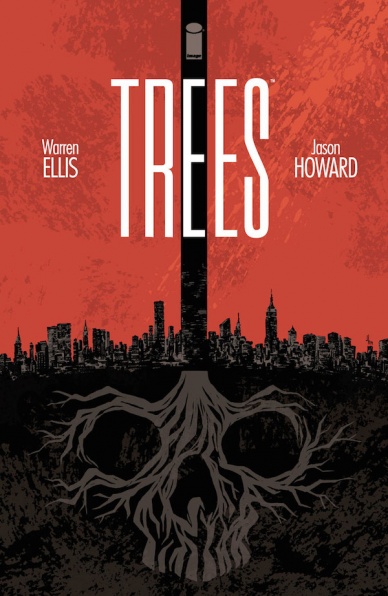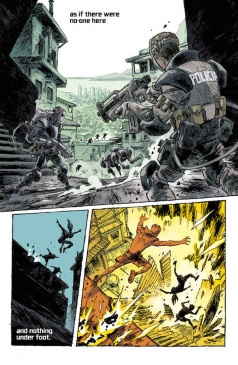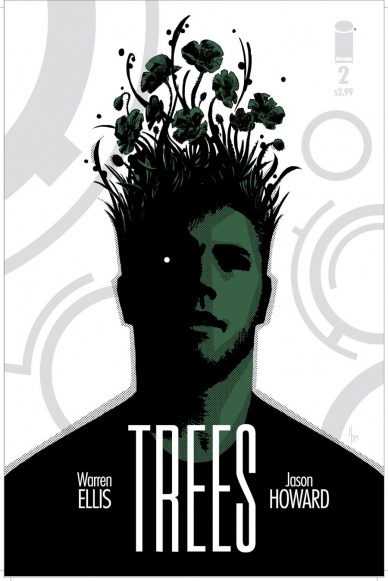
Like you (we assume), we’re quite big fans of the work of Warren Ellis. One of the most influential writers in comics today, the man behind such opus magnum as “Planetary” and “Transmetropolitan”, Ellis has recently returned to comics after some time off writing novels and doing — well, whatever it is Ellis does when not writing comics. But now that he’s back in comics, he’s back in full force, with the critically acclaimed “Moon Knight” tearing up shelves and recent announcements “Trees” and “Supreme: Blue Rose” getting Image fans quite excited.
So today, as part of our continued fifth anniversary celebration, we sat down to chat with Warren Ellis all about comics, his return, the upcoming series “Trees” with Jason Howard and more. (And be sure to come back next week for more of us talking with Warren.)
You took some time off from writing comics, but now you’re back. Were there any reasons besides writing your novel and novella that made you want to take a break from comics, and did that period change the way you thought about the medium?
WE: I mostly just needed to focus on the novel and other things. I don’t know if I particularly needed to recharge or something — I’m probably working harder than ever, these days — but it was time to take up some of the opportunities that heavy-deadline comics work prevented me from doing in the past. I have actually been writing comics slowly and steadily for about a year now — what’s happening at the moment is that you’re just finding out about things I’ve been working on for a very long time.
Distance from comics gave me some… different thoughts, maybe, about the medium? Working in prose changes your perspective about things like how comics handles information, for example. But that’s a much longer conversation, and one that isn’t completely crystallised in my head yet. Not least because I’m currently writing a long novella for FSG with my other hand, and having to change gears between it and the comics work in front of me today (TREES #5).

Since your return, we’ve seen you doing for-hire work at Marvel, but many know and love your writing from your creator-owned output. In the past few years, that area of comics has been through a significant boom period, creatively and commercially. What do you think is driving that boom, and what do you think is pushing Image to the head of that class?
WE: I’m sure Image would appreciate the push question there! But the honest truth is that I don’t pay enough attention to the weather of the medium to give you an answer, informed or otherwise. Which I know sounds like, “oh, another pompous comics writer who thinks he’s too good to read comics.” But the fact is that I’m writing so much, and have to take in so much information every day, that I only have time for research reading or, if I’m lucky, to whittle down the stack of books I have to write promotional blurbs for. (I just read Blake Butler’s THREE HUNDRED MILLION, by the way, which is hands-down brilliant.) Also, I can’t read a lot of fiction when I’m writing fiction, which is why I’m saving the book Ace Atkins is sending me for when I’m next on a long plane trip.
That was a long answer that was also no answer at all, wasn’t it? Go and read THE KING IN THE NORTH by Max Adams, chock full of British history that even I, a longtime history buff, didn’t know.
How did Trees end up at Image, and what made it the perfect home for the book?
WE: Eric Stephenson and I talk every week, even when I’m not writing comics, because he’s an old friend. I have a relationship with Image, Jason obviously has a long relationship with Image, we both love the people there — it was simply the obvious place to do the book.
What is it about science fiction as a genre to work in that you continue to find alluring, and what’s different about Trees from other entries into the genre that we’ve seen in the past?
Continued belowWE: I’m not pitching you, so I can’t tell you what makes TREES different. All I can say is that, for me, science fiction remains the best tool for a certain kind of social fiction, and the set-up of TREES itself, where the Trees are more of a pressure than an actor, allows me to write a certain kind of novelistic fiction, where I can assemble several kinds of stories under a theme and setting and have it make some kind of connective sense. It might be my John Brunner THE SHEEP LOOK UP/STAND ON ZANZIBAR phase, I don’t know.
Jason Howard is known by many as the artist of Super Dinosaur, but as we learned with Scatterlands he’s not someone defined by a style or genre, but by his ability to tell a story visually. What made him the perfect collaborator for this book, and what’s the creative process between the two of you as you’ve been developing the story?
WE: What happened was, as we got deeper into SCATTERLANDS, we realised we wanted to work on something bigger together. We got talking about what we might like to do, and what he might like to draw, and I generated TREES out of those conversations. A lot of the process was Jason sending over scads of stuff from his personal art-inspiration files, and me fashioning something that hit as many of his pleasure centres as possible. Sometimes I don’t include enough robots. It’s an ongoing process. But I think that, if you only know Jason’s work from SUPER DINOSAUR, or even just SCATTERLANDS, then you’re not really ready for what Jason can do.
In regards to collaborating with Jason, you’ve said that Trees will heavily feature detailed splash pages, which seems almost like adapting the Scatterlands digital one-panel structure for print. What is it about this type of layout that you and Jason have found so fruitful in terms of delivering story and additional information to the reader?
WE: It’s not at all like SCATTERLANDS, because all SCATTERLANDS panels were the same size. The Trees themselves are objects of extreme scale, extreme height, so the process of encapsulating their presence became part of the visual language of the book.

You’ve done webcomics before with FreakAngels, but given the digital experiment of Scatterlands, do you feel that experience changed the way you look to convey information to readers?
WE: Not especially. Each story comes with its own way of telling it. SCATTERLANDS was a low-information form, just a bit of fun, trying out a certain little group of ideas. (I’d do a daily comic again in a second, by the way, if anyone wants to pay me and an artist to do that. And Jason and I will do the second tranche of SCATTERLANDS panels when we come up for air — we got too involved in TREES to think about it right away.)
I saw you mention that you have 8 issues planned for Trees, but that the book could also go on for years. What are your goals for the story, and what makes it so important for Jason in having a number of issues completed before the book launches?
WE: Wanting it to be serialised in a reasonable fashion? And, also, to give me the time to write it — it’s a relatively complicated thing, that has several storylines running in parallel, and I need to keep it all straight, because I’m writing each storyline in a separate document before combining portions of them for each single issue. Every time I sit down to write some TREES, I’m essentially deciding whether I’m writing in TREES/Cefalu, TREES/Arctic, TREES/Shu, etc.
Issue 5 will be in the can before issue 1 is published. I’ll probably be well into issue 6, on my part, and able to see the light at the end of the tunnel.
You’re known for staying up-to-date on the bleeding edge of science, or at least as much as you can be. How much does that research and interest influence your work on books like Trees?
WE: Less than you’d think, on TREES — it’s mostly just inciting or incidental details, like DIY drone hacks, or Special Economic Zones in China. An interview I read with an African premier, some old knowledge about the fascisti in contemporary Italy. Mostly just things providing some kind of backdrop to my thinking or a little verisimilitude in the pages. TREES is very much more about the people than the things, if you see what I mean.
Continued below(All of the above, really, is about the value of research: it becomes part of the fabric of the story, rather than the point of the story. And also why I have a 27-inch screen here running five columns of Twitter lists all day. Technically, I’m “dark” right now — not participating on the social internets, because I have a novella and a long short story and five other things to do and I need to be low-signal in order to focus. But the Twitter lists are always up, scrolling out news and information from a great number of sources. It’s a big glanceable that gives me something new whenever I look up at it. I don’t know another way to work.)
Comics are ostensibly the same today as they ever have been, yet you’re someone who often likes to play with form and format of the books you work in. Is there anything fundamentally different for you working on Trees in 2014 than, say, the end of Transmetropolitan in the early 00’s?

WE: Oh god. TRANSMET seems so long ago! But, no, the time difference isn’t the thing. It’s a different kind of story, with a different atmosphere. TREES is a less frenetic and hysterical book. It’s a slow burn, in a lot of ways, with more complex personalities and relationships.
In terms of designing the nature of the eponymous Trees of the book, you mentioned the work done for the visual language of the book. Given that science fiction often re-designs known elements of our world, how do you and Jason approach reinventing the world around us for this series?
WE: No, it’s set in a recognisable near future. Imagine the difference between the streets of 2000 and the streets of today — it’s that kind of spread of alteration. Think of it as the world around the corner, where we see what Google was really up to when it tested self-driviing cars and bought robot manufacturers.
So before your comic sabbatical, your comic work over at Avatar analyzed the human condition via other-worldly elements, and it seems Trees will be in the same vein. Given that you’re always sort of plugged into the world around you, do you feel that often leads you to narratives that highlights the darkness humanity is capable of?
WE: I don’t know it’s even about the darkness, so much as it’s about the complexity and the nature of the choices presented to us. Even the least-bad choice can be lethal to someone. It’s a rough planet.
You’ve long been a proponent of digital, and have suggested in the past that it very much is the future of comics in many ways. The big splash in terms of self-controlled digital comics has been “The Private Eye” through Panel Syndicate. In your perspective, is that model something that could be used by a wider population of creators? Or do you think it’s something that is very much dependent of some level of existing notoriety in comics?
WE: I don’t really know what the state of digital comics is right now — I’ve been more focused lately on digital prose enterprises — but webcomics had any number of inventive ways to monetise their work in the past, and the next generation of crowdfunding sites, like Patreon, add further options. Patreon may well prove to be a system to watch, as it can be adapted to become a simple subscription service for comics.
You’re having a banner year, so far, with Moon Knight earning major accolades, Trees coming soon, another novella in the works, and the recently announced deal with Dynamite. Do you have any other projects in the works in the rest of 2014?
WE: Yes. I’m just not telling you about them.

Looking ahead, some of today’s biggest creators were members of your forums before they were prominent writers and artists, like Matt Fraction, Kelly Sue DeConnick and Ales Kot. As someone who has helped shepherd the industry and who has been able to watch these creators rise, how do you feel about the future of comics?
WE: Never ask anyone who talks about the future to predict something. It’s like handing you a stick called WRONG to beat me around the head with in three years’ time. I don’t even do that when I speak at future-y places. Remember when the Singularity was originally supposed to happen? Also, all those people you mention owe me money now, here in my impoverished dotage. That was the plan all along.
“Trees” #1 hits stores later this month, May 28th.






